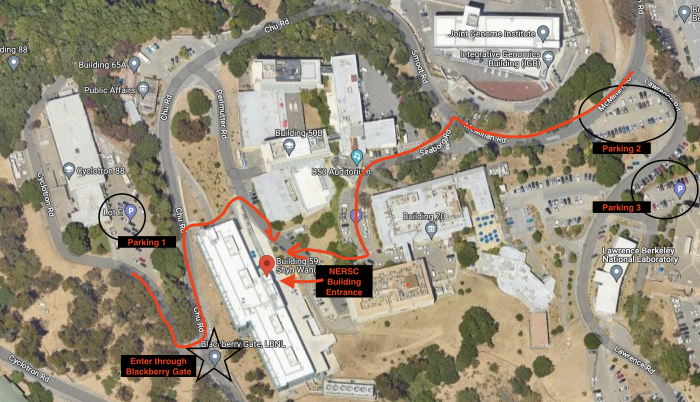GPUs for Science Day, Oct. 12, 2023
GPUs have been instrumental in ground-breaking innovations, from scientific simulations to generative AI. This year, NERSC is proud to host the annual GPUs for Science event in person. Our goal is to celebrate recent GPU-enabled scientific achievements and inspire future roadmaps. The day will start with an introduction to three DOE compute facilities (NERSC, ALCF, and OLCF), followed by a series of talks on GPU-accelerated scientific applications and emerging software programming models. The day will wrap up with a panel of leading industry experts discussing their vision for upcoming GPU ecosystems.
With increasing diversity in GPU hardware and software, users interested in performance and portability across DOE supercomputers are highly encouraged to join. The event is also open to everyone interested in learning about the exciting science in action.
Logistics
- Meeting type: In-person (with optional Zoom attendance)
- Location: Lawrence Berkeley National Lab (Berkeley Lab), Bldg 59 (NERSC), Room 3101
- Date: October 12, 2023 (Thursday)
- Time: 8:30 a.m. - 5 p.m. (Pacific Daylight Time, UTC-7)
- Recording available on YouTube
Registration
- In-person attendee registration is now closed.
- Online attendee (live stream) registration is closed.
Agenda*
| Title | Speakers | Affiliation | Time PDT (UTC-07) |
|---|---|---|---|
| Breakfast and Registration | 8 a.m. | ||
| Opening Remarks | Jack Deslippe | LBNL | 8:45 a.m. |
| Session 1: Compute Facilities | 9 a.m. | ||
| Perlmutter system at NERSC |
Debbie Bard Hannah Ross |
LBNL | 9:05 a.m. |
| The path to Aurora | Jae Hyuk Kwack | ANL | 9:25 a.m. |
| Science from GPUs on the Frontier Exascale Supercomputer | Balint Joo | ORNL | 9:45 a.m. |
| Break (10 mins) | 10:05 a.m. | ||
| Session 2: Applications | 10:15 a.m. | ||
| Harnessing GPUs for science: lessons from the Exascale Computing Project | Erik Draeger | LLNL | 10:15 a.m. |
| Towards the Convergence of Data-Driven and Kinetic Models at Exascale | Axel Huebl | LBNL | 10:35 a.m. |
| Global Cloud Resolving Modeling on Exascale Computers | Mark Taylor | Sandia | 10:55 a.m. |
| ExaCA: exascale component-scale microstructure simulation | Sam Reeve | ORNL | 11:15 a.m. |
| Exascale Flow Simulations for Energy Science | Paul Fischer | ANL | 11:35 a.m. |
| Q&A Session over lunch (45 mins) | 11:55 a.m. | ||
| Enhancing Science: Efficient Julia Workflows and GPU Use on Perlmutter with Jupyter | Marius Millea | UC Davis | 12:40 p.m. |
| Accelerating Molecular Discovery and Design with AI: Insights from the Open Catalyst Project | Brandon Wood | Meta | 1:00 p.m. |
| Then and Now: How GPUs Empower ECP Mathematical Libraries | Sherry Li | LBNL | 1:20 p.m. |
| AMReX and selected AMReX-based applications |
Ann Almgren Weiqun Zhang |
LBNL | 1:40 p.m. |
| Break (10 mins) | 2 p.m. | ||
|
Session 3: Programming Models |
2:10 p.m. | ||
|
A Task Graph-based Programming System for CPU-GPU Heterogeneous Computing |
Dian-lun Lin | UW - Madison | 2:10 p.m. |
| Stellar Mergers as a Benchmark: Performance of Octo-Tiger, HPX and Kokkos on Perlmutter | Gregor Daiß |
University of Stuttgart / LSU |
2:30 p.m. |
|
Evaluating the Performance of One-sided Communication on CPUs and GPUs |
Nan Ding | LBNL | 2:50 p.m. |
| Break (20 mins) | 3:10 p.m. | ||
| Session 4: Emerging Hardware and Software Ecosystems | 3:30 p.m. | ||
| NVIDIA's Accelerated Computing Ecosystem | Scot Halverson | NVIDIA | 3:30 p.m. |
| Software & Hardware Co-design for Exascale Scientific Computing | Michael Rowan | AMD | 3:45 p.m. |
| Future-Proofing Your Science: Programming GPUs (and More!) with Open Standards | John Pennycook | Intel | 4 p.m. |
| Panel Discussion (30 min) | 4:15 p.m. | ||
| Closing Remarks | Weile Wei | LBNL | 4:45 p.m. |
| Adjourn | 4:55 p.m. |
*Agenda subject to change
Visitor Information
Please refer to our visitor information page and an interactive map of the Berkeley Lab campus. An area map is shown below for quick reference.
Location of the meeting: Building 59/Shyh Wang Hall
Organizing Committee
Mukul Dave
Muhammad Haseeb
Dhruva Kulkarni
Weile Wei
About Berkeley Lab
Lawrence Berkeley National Laboratory is a multidisciplinary national laboratory located in Berkeley, California, on a hillside directly above the campus of UC Berkeley. The site consists of 76 buildings located on 183 acres, which overlook both the campus and the San Francisco Bay.









